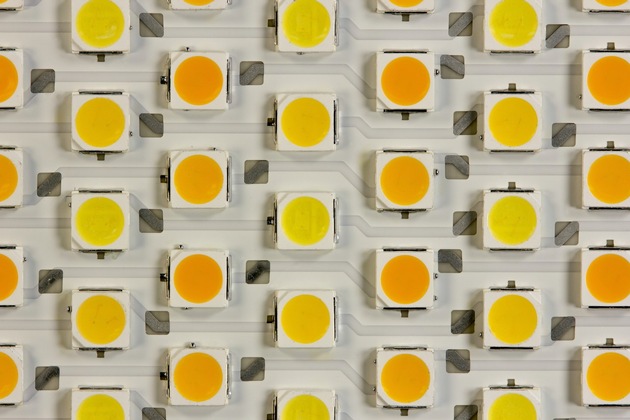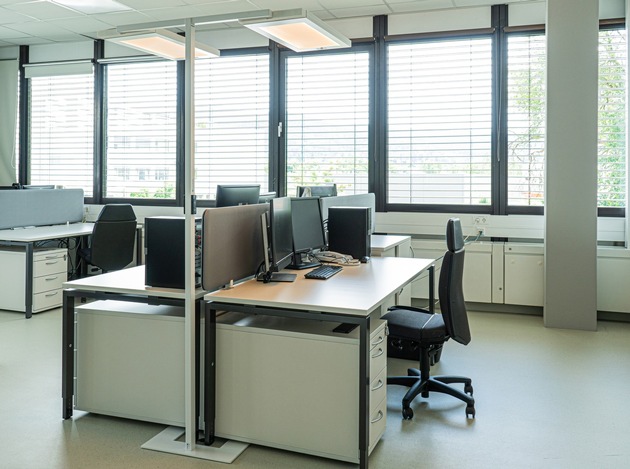Fraunhofer Institut für Angewandte Festkörperphysik IAF
In the right light—intelligent and sustainable LED work lighting
Successful project completion demonstrates human-centered LED lighting for industry and office space: The Fraunhofer Institute for Applied Solid State Physics IAF, in cooperation with the Chair of Microelectronics at the Department of Microsystems Engineering (IMTEK) of the University of Freiburg and Hahn-Schickard, has developed reliable, demand-oriented and resource-saving LED lighting for workplace and office applications. The lighting concept includes an intelligent, energy-saving light and luminaire control system geared to the needs of working people.
Light is much more than just a means of perception, it has an unseen effect on motivation, concentration and well-being. Lighting in the workplace in particular has an enormous impact on the health and performance of employees. However, in order for them to sit in the right light, a comprehensive approach to lighting is required, taking into account environmental influences and individual needs. The Fraunhofer IAF research team, together with their project partners IMTEK, Hahn-Schickard, and with the advice of Herbert Waldmann GmbH & Co. KG, have combined all these factors in a lighting concept.
In the successfully completed joint project SusLight_works, short for smart and sustainable LED lighting for workplace and office applications, two fully functional demonstrators in the form of an office floor lamp and a linear workplace lighting system were created. The reliable, demand-oriented and resource-saving LED lighting systems have an intelligent, energy-saving light and luminaire control system based on the needs of the working person and their environment. A special focus was placed on utilizing the advanced functionalities of LEDs in combination with innovative sensor technology and wireless control.
“The smart and sustainable LED lighting of SusLight_works can contribute significantly to energy saving in building illumination and save valuable raw materials and production costs due to its longevity. At the same time, it has the potential to support workforce in terms of ergonomics and biorhythms by generating light in different brightness and color temperature as needed and adapting it to the activity and the course of the day,” emphasizes Dr. Michael Kunzer, project coordinator at Fraunhofer IAF.
Energy saving potential through efficient LED technology
As an efficient, environmentally friendly and long-lasting light source, the LED has been on the rise for several years. However, as a result of its increasing prevalence, a number of challenges are also becoming apparent. “In many commercial LED luminaires, the driver electronics generate energy losses and premature failures,” explains Dr. Kunzer.
In order to promote the sustainability of LED lighting, the project developed a highly efficient LED driver using ASIC design and GaN-on-Si power electronics from Fraunhofer IAF. This driver does not require electrolytic capacitors and thus does not have the critical element that limits the life expectancy of common driver electronics. In addition, the GaN-based LEDs achieve a luminous efficacy of up to 210 lumens per watt (lm/W). The LED technology of SusLight_works thus offers one of the highest energy efficiency classes even according to the new Ecodesign Directive for light sources, which comes into force in Europe in September.
It all depends on the right light
“The full potential of LEDs goes far beyond energy savings. As a dynamic light source, they offer functionalities such as lossless dimming, variable color temperatures and adaptive light fields—all of which are crucial for human-centered lighting, or HCL,” says Dr. Kunzer. In order to take full advantage of these benefits of LED semiconductor light sources, the researchers of SusLight_works have developed an integrated light sensor that is modeled after the human eye and constantly monitors the color temperature and illuminance of the available ambient light.
The integrated sensor technology automatically detects the color temperature and illuminance at the workplace. In addition, control electronics and software adjust the luminous intensity as well as the color temperature of the lamp according to a predefined lighting profile. The profiles can be created individually and according to the activity via app. The installed LED modules have four channels that provide a color temperature of 2200 to 6500 Kelvin and can thus reproduce the dynamics of daylight inside a building. A high color-rendering index (CRI > 80) ensures that the color fidelity of the light spectrum corresponds as closely as possible to the ideal of the sun.
------------------------------------------------------------------------------------------------------
About SusLight_works
The demonstrator project SusLight_works started in 2019 as part of the Sustainability Center Freiburg and was successfully completed in summer 2021. Interdisciplinary competences from the fields of microelectronics, smart sensors, chronobiology and consumer behavior were bundled to demonstrate resource-saving and demand-oriented LED workplace and office lighting. The project consortium, led by Fraunhofer IAF, consisted of the University of Freiburg (IMTEK), Hahn-Schickard and the industrial consultant Herbert Waldmann GmbH & Co. KG. The project developed two fully functional demonstrators with built-in detection, control and closed-loop tracking of illuminance and color temperature.
The Ministry of Science, Research and the Arts Baden-Württemberg, the Ministry of Finance and Economics Baden-Württemberg and the Fraunhofer-Gesellschaft funded the project.
About Fraunhofer IAF
The Fraunhofer Institute for Applied Solid State Physics IAF is one of the world's leading research institutions in the fields of III-V semiconductors and synthetic diamond. Based on these materials, Fraunhofer IAF develops components for future-oriented technologies, such as electronic circuits for innovative communication and mobility solutions, laser systems for real-time spectroscopy, novel hardware components for quantum computing as well as quantum sensors for industrial applications.
With its research and development, the Freiburg research institute covers the entire value chain - from materials research, design and processing to modules, systems and demonstrators.
About Hahn-Schickard
Hahn-Schickard develops intelligent cross-industry products using microsystems technology, from the first idea through production to the final product. The research and development service provider has institutes at four locations in Baden-Württemberg including Stuttgart, Villingen-Schwenningen, Freiburg and Ulm. In close cooperation with the business sector, Hahn-Schickard realizes innovative products and technologies in the fields of sensors, intelligent embedded systems for the internet of things, artificial intelligence, lab-on-a-chip and analytics, as well as packaging and interconnection technology and electrochemical energy systems. The range of services includes small, medium and large-scale production.
About IMTEK
As part of the University of Freiburg, the Department of Microsystems Engineering (IMTEK) comprises more than 24 professorships and research chairs, covering the wide spectrum of microsystems technology. IMTEK is therefore one of the world's largest academic institutions in the copious field of mirosystems technology, pushing academia forward in the fields of electronics, mechanics, material sciences, optics, fluidics, sensor technology, medical technology and many more. Additionally to IMTEK's many research labs, it is equipped with a clean room, offering a variety of services to those working in the field of microsystems engineering. The IMTEK cooperates with Hahn-Schickard in numerous areas to ensure the transfer of the latest research results into the industrial environment.
About Waldmann
Anyone based in the Black Forest must shine very brightly indeed. Today, the fourth generation of the Waldmann family develops lighting solutions that provide people with the optimum support whatever they are doing, whether in the office, on machinery, in industrial workplaces or working in healthcare. The "Engineers of Light" are constantly re-thinking light. For over ten years, Waldmann's biodynamic luminaires (Human Centric Lighting) have been providing people who spend a lot of time working indoors with the positive effects of natural light. With its digital solutions, the lighting experts are able to get the most out of the floor space and the company's staff and increase safety in healthcare.
Fraunhofer Institute for Applied Solid State Physics IAF Tullastraße 72 | 79108 Freiburg | Germany
Lukas Kübler Marketing and Communications +49 761 5159-261 www.iaf.fraunhofer.de/en

